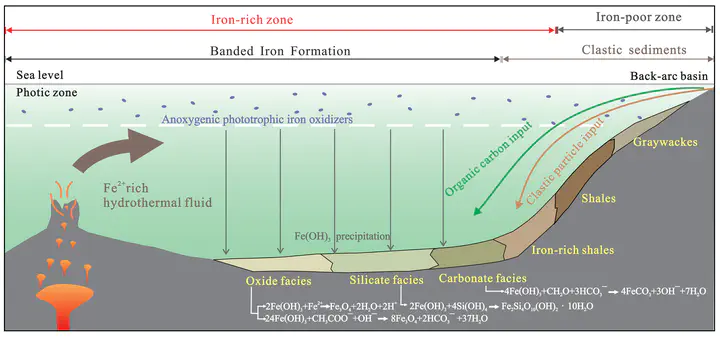Depositional and environmental constraints on the late Neoarchean Dagushan deposit (Anshan-Benxi area, North China Craton): An Algoma-type banded iron formation
 Depositional model for the Neoarchean Algoma-type Dagushan BIF.
Depositional model for the Neoarchean Algoma-type Dagushan BIF.
Abstract
The late Neoarchean, ~ 2.53 to 2.51 Ga Dagushan banded iron formation (BIF), is a typical Algoma-type BIF located in the northeast part of the North China craton. Despite having undergone upper greenschist to lower amphibolite facies metamorphism, the Dagushan BIF retains evidence of varied depositional facies, making it an ideal archive to evaluate the paleomarine environment and the paragenesis of the ore minerals. A transition from oxide to silicate to carbonate facies BIF is evident in a northward direction. The mineralogical composition shifts from magnetite and quartz in the south through a magnetite-quartz-cummingtonite/stilpnomelane assemblage in the transition zone to magnetite-siderite in the north. Such a distinct distribution of mineralogical facies correlates well with the depositional environment of the BIF. The carbonate facies BIFs formed in a near-shore, proximal environment, whereas the oxide and silicate facies BIF assemblages formed in deeper waters, distal to the paleoshoreline. The BIF samples display characteristic seawater-like rare earth element + yttrium (REE + Y) profiles with positive La and Y anomalies and heavy REE enrichment relative to the light REEs when normalized to post-Archean Australian shale. Positive Eu anomalies suggest a high-temperature hydrothermal contribution to the BIF. The absence of a negative Ce anomaly in nearly all samples, coupled with positive δ56Fe in magnetite in all mineralogical facies, indicates a dominantly anoxic water column contemporaneous with deposition of the BIF. At ~ 2.53 Ga in the Anshan area, seawater was mostly anoxic and rich in ferrous iron. Dissolved ferrous iron in upwelling hydrothermal fluids was oxidized and precipitated as Fe(III) oxyhydroxides in the photic zone leading to BIF formation. Proximal to hydrothermal vents, magnetite formed via the reaction of Fe(III) oxyhydroxides and aqueous Fe(II) supplied from the hydrothermal fluids and microbial dissimilatory iron reduction (DIR) coupled to organic carbon oxidation. Proximal to a paleoshoreline, siderite formed through DIR, as evidenced by the depleted δ13C values and the presence of graphite. Silicates, such as stilpnomelane and cummingtonite, are considered to be the metamorphic products of early diagenetic silicates (e.g.,~nontronite) that formed in the water column from admixtures of Fe(III) oxyhydroxides and amorphous silica.